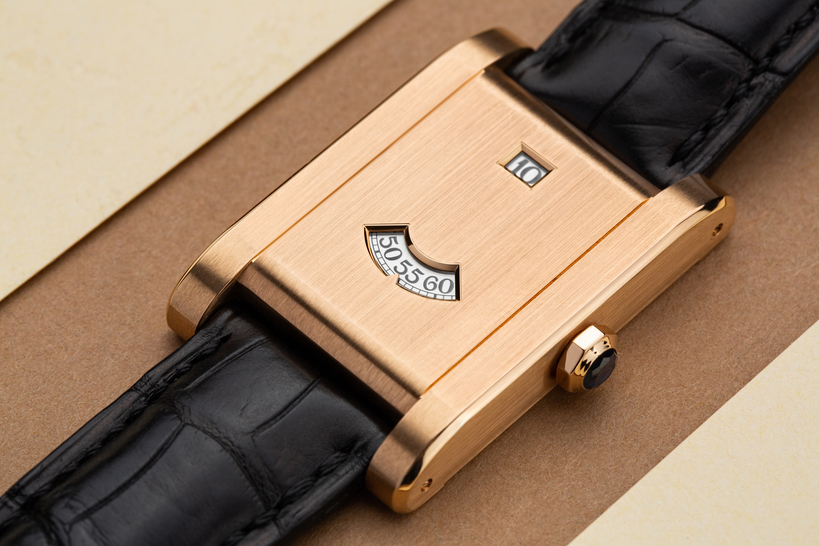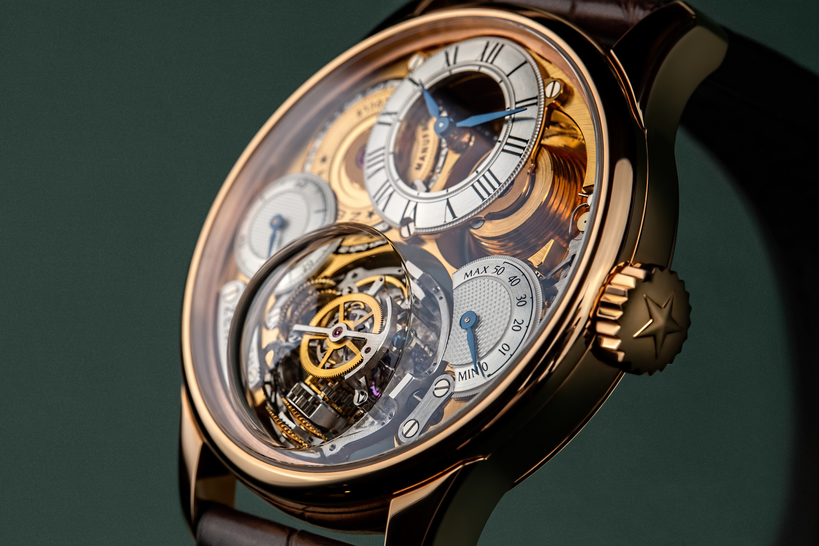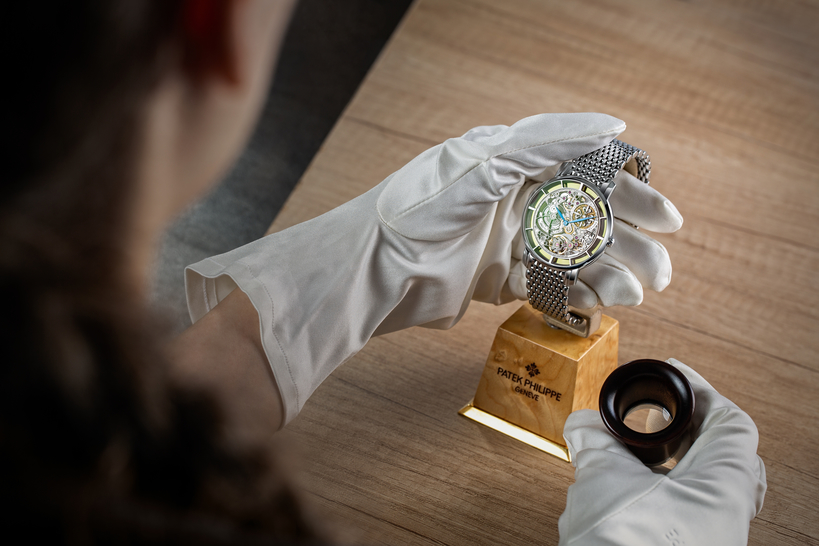This part is about the pioneers of ultra-thin watchmaking, and we're going to tell you which manufacturers achieved real progress in this field.
One of the first wristwatches in the ultra-thin category was made by the Swiss company Frédéric Piguet, which began manufacturing the ultra-thin Caliber 21 in 1925 (20.4 mm in diameter and 1.73 mm thick).
In the mid-1950s, an ultra-thin wristwatch movement was developed jointly for mass production by the companies Vacheron Constantin, Audemars Piguet and Jaeger-LeCoultre (sold by the brands as the Jaeger-LeCoultre 803, Audemars Piguet 2003, and the Vacheron Constantin 1003), which were 21.05 mm in diameter and 1.64 mm thick. An upgraded version of this movement is still made today.
The same three companies really excelled in 1967, when they developed a self-winding ultra-thin movement with a full center rotor which was 2.45 mm thick. It's also still produced today, sold as the Jaeger-LeCoultre 920, Audemars Piguet 2020, and the Vacheron Constantin 1120. These venerated masters of thin watch movements couldn't rule out that one day, their elite club would be joined by newcomers.
That's exactly what happened. In the 1950s, the Swiss brand Piaget set itself the challenge of creating its own thin movements, and the 2 mm hand-wound Caliber 9P entered production in 1957. Then in 1960, the record-breaking 2.3 mm Caliber 12P was unveiled as the world's thinnest self-winding movement, with a micro-rotor for its automatic winding.
The USSR's watch industry couldn't resist the temptation of creating its own ultra-thin caliber, and pulled out all the stops. In 1965, the First Moscow Watch Factory began manufacturing the slim Poljot 2200 watch that housed the hand-wound Caliber 2200, a movement which was just 1.85 mm thick.
In 1965 the First Moscow Watch Factory began manufacturing the hand-wound Caliber 2200, a movement which was just 1.85 mm thick
Very few of these movements were made and have become trophies that collectors are now eager to hunt down for themselves, and prices for surviving copies have gone through the roof. At the end of the 1960s, it became fashionable to wear thicker and bolder watches, yet the more conservative style of smaller and thinner watches still held onto quite a strong fanbase.
Many of the watches created in the preceding decades were in need of an upgrade, and shock resistance was perhaps the most sorely needed of them, but new and occasionally surprising technical solutions were also invented. Far from every project launched back then has stood the test of time, and it is even difficult to find information about some of them.
In 1970, the Swiss movement factory Frédéric Piguet designed the ultra-thin automatic Caliber 70 with an off-centered rotor for its automatic winding, which was 2.4 mm thick. This was a hybrid concept, a compromise between the full center rotor for its automatic winding and the micro-rotor.
However, it was the upgraded successor of the Caliber 70 that was a real success — the Caliber 71 — which has been made since 1975 and is still made to this day, now better known as the Breguet Caliber 502.3SD. It was around that time when Japanese watchmakers joined the race to make thinner watch movements.
Seiko appeared on the scene with the Caliber 6800 in 1969, which was the thinnest manual-winding movement manufactured by a Japanese company at 1.9 mm. An upgraded version of this movement is still made by the Japanese brand to this day, albeit in very small quantities. In the 1970s, the Swiss watch company Jean Lassale made use of designs by Swiss master watchmaker Pierre Mathys to launch the world's thinnest mechanical watch movement.
The first prototype presented in 1976 was called Caliber 1200, and was 1.3 mm thick. Another movement built based on this one was the ultra-thin Lassale automatic Caliber 2000 with a center rotor, a movement which was 2.08 mm thick. This significantly slimmer movement compared to the traditional construction was achieved by mounting the watch's wheels and the mainspring barrel on miniature ball bearings.
Both of the movements based on Mathys' design attracted global interest, and a number of watch brands added ultra-thin watches with these movements to their collections. However, this is where their story ends, because despite all their technical feats, these movements weren't reliable enough for everyday wear.
Around the midlle of the 1970-s the Japanese watchmakers joined the race to make thinner watch movements
Driven by fast-paced technological advances in quartz watches at the end of the 1970s, watchmakers tried to make quartz movements as slim as possible, in comparison to the first fairly chunky quartz calibers. The consortium of Swiss watchmakers and movement manufacturer ETA designed 1.98 mm watch cases as part of the Delirium line in 1979.
The watch components were supplied by consortium members, who sold the watches under their own brand names: Longines called its model Feuille d'Or ('Gold Leaf'), Eterna had Espada Quartz, Concord had Delirium, and Omega released the Dinosaur.
The watch was then condensed to 1.48 mm (the Delirium 2 series), and then ultimately pared down to 0.98 mm (the Delirium IV in 1980). One thing that all the Delirium quartz movements had in common was their integral construction, i.e. the casebacks of these watches served as the main plate for the movement.
In 1980, the Japanese company Seiko unveiled the skinniest classic three-handed, manually-wound quartz movement — the Caliber 6720 — which was 0.9 mm thick and used in watches sold by the brand Seiko Lassale.
In 1985, the Japanese company Casio began manufacturing the thinnest and lightest digital quartz watch of its time, the Pela FS-10, which had a 3.9 mm case and weighed 12 g. In 2016, Japanese Citizen Watch Co. designed the Eco-Drive One watch with the world's thinnest movement — the solar-powered Caliber 8826 Eco-Drive — which was exactly 1 mm thick.
Quartz movements were developed at an unbelievably aggressive pace in the 1970s, when many watch companies switched to using quartz, yet despite pessimistic predictions, this new technology failed to put an end to traditional mechanical watchmaking. Working together with the developers of quartz movements, Patek Philippe devoted considerable attention to the development of a line of mechanical movements.
One of the movements designed by the watch manufacturer in 1977 was the slim Caliber 240 self-winding movement with a decentralized micro-rotor, which was 2.53 mm thick. The first watch to house Patek Philippe's new thin movement was the slender gentleman's Ref. 3738 Golden Ellipse with a 5.8 mm case, followed by other classic thin models. It was also used as a basis to create movements for complicated mechanical watches.
The integral construction of watches with the caseback as the main plate was not consigned to the past. It was one of the fundamental technical solutions used in the Delirium quartz watch project, the same solution used much earlier by Philippe Samuel Meylan in his ultra-thin pocket watches.
In 1986, the Swiss luxury watch manufacturer Audemars Piguet used this integral construction to design the watchmaker's first ultra-thin self-winding tourbillon wristwatch, which had a 4.8 mm case. However, Audemars Piguet didn't see this as a very promising field, and like the majority of other brands, they later reverted back to manufacturing thin watches using the classic technology, keeping the movement and case separate.
The Swiss luxury watchmaker Piaget made another return to the integral design in the 2010s. Piaget is one of few brands which specifically focus on developing this field of thin watches and movements. The reason is that the possibilities of building ever-thinner watches still more or less fit for everyday wear using the traditional technology with a separate movement and case have probably been exhausted.
Piaget still obviously wanted to go further. The brand's collections have already included the hand-wound 2.1 mm Caliber 430P, which is the successor of the Caliber 9P from 1957, and the self-winding 2.35 mm Caliber 1200P with a micro-rotor, which is the successor of the Caliber 12P from 1960.
The technical feat of using the caseback to perform the role of the main plate for the movement allowed watchmakers to smash the 4 mm limit for manually wound watches along with the 5 mm limit for automatic watches. The brand released its first watch with this integral construction in 2013.
The Altiplano 900P watch was built in this way, and was the world's thinnest manual-winding wristwatch at the time when it was unveiled, which had a 3.65 mm case. At the end of 2017, the watchmakers at Piaget presented the result of further progress which had been made thanks to this integrated construction: a form of conceptual art called the Altiplano Ultimate Concept watch with a case that was 2 mm thick.
At the end of 2017, the watchmakers at Piaget presented the result of further progress which had been made thanks to this integrated construction
The brand started mass producing this model in 2020. At the end of 2017, the self-winding Altiplano Ultimate Automatic 910P watch based on the same integral construction was also presented, wound by a peripheral oscillating weight. The watch's case was 4.3 mm thick.
However, it's still possible to build even thinner watches in the classic way with a separate movement and case. Jaeger-LeCoultre proved this in 2015, when the Swiss luxury watch company presented the Master Ultra-Thin Squelette watch with its ultra-thin 1.85 mm Caliber 849 and its 3.60 mm case, which broke the record set by the Altiplano 900P.
Every hundredth of a millimeter counts in the art of thin watchmaking. What makes this watch particularly impressive is that it was skeletonized and decorated with enamel. A year earlier in 2014, Jaeger-LeCoultre added the Master Ultra-Thin 1907 to its collection, which was a classic version in terms of decoration. It was powered by the classic unskeletonized version of the Caliber 849 and had a case that was 4.05 mm thick.
In 2020, the brand introduced another ultra-thin model called the Master Ultra Thin Kingsman Knife with a 4.25 mm case. The watch's design recreates typical features of ultra-thin pocket watches from the early 20th century, and is equipped with the Caliber 145. This watch gets its name from the ‘Couteau’ (Fr. 'knife') pocket watches and the sharp edge of their cases.











